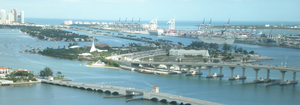MacArthur Causeway
MacArthur Causeway County Causeway | |
|---|---|
 The entirety of the causeway, connecting Downtown and South Beach | |
| Coordinates | 25°46′40″N 80°09′51″W / 25.777711°N 80.164233°W |
| Carries | 6 lanes of |
| Crosses | Biscayne Bay |
| Locale | Miami to Miami Beach |
| Official name | General Douglas MacArthur Causeway |
| Maintained by | FDOT |
| Characteristics | |
| Design | Causeway, beam, girder |
| Material | Slabs, girders, fill |
| Total length | 3.5 miles (5.6 km) |
| Longest span | 0.4 miles (0.64 km) |
| Clearance above | 68 feet (21 m) |
| History | |
| Designer | Frederic R. Harris, Inc., American Bridge Company |
| Opened | February 17, 1920[1] |
| Location | |
 | |
The General Douglas MacArthur Causeway is a six-lane causeway that connects Downtown Miami to South Beach via Biscayne Bay in Miami-Dade County.
The highway is the singular roadway connecting the mainland and beaches to Watson Island and the bay neighborhoods of Palm Island, Hibiscus Island, and Star Island. The MacArthur Causeway carries State Road 836 and State Road A1A over the Biscayne Bay via a girder bridge. Interstate 395 ends at Fountain Street, the entrance to Palm Island Park which has a traffic light as well as bus stops.
History[edit]
In the late 1910s, with the deteriorating wooden Collins Bridge (now, the Venetian Causeway) as the only direct land route between mainland Miami and the barrier islands of Miami Beach, construction on the roadway began in 1917. The roadway, dedicated as the County Causeway, was completed in 1920. Watson Island was reclaimed surrounding the western end of the roadway, completed in 1926.
Having undergone several lane and structural expansions following opening of the original two-lane road, the State Road Board and Dade County Commission voted to rename the causeway in honor of World War II General Douglas MacArthur in 1942.[2] The causeway was accessible from mainland Miami via Biscayne Boulevard and intersecting side streets through the 1960s. Construction of direct highway access to I-395 was complete in the 1970s. The replacement of the westernmost and easternmost spans began in the 1990s, as the eastbound lanes of the bridges were completed in 1995 and westbound lanes finished in 1997.
Gallery[edit]
-
Large portion of the causeway. Fisher Island and Port of Miami are in the background. Watson Island is in the foreground.
-
MacArthur Causeway eastbound from Miami to Miami Beach (in far background).
-
Macarthur Causeway at night as seen from Watson Island
References[edit]
- ^ Lavender, Abraham (2002). Miami Beach in 1920. Mount Pleasant, SC: Arcadia Publishing. p. 160. ISBN 0-7385-2351-8.
- ^ "Causeway Our Thanks for Bataan". The Miami News. April 6, 1964. p. 1A. Retrieved October 20, 2010.
External links[edit]
- MacArthur Causeway at Structurae, 2006
- Roads in Miami
- Roads in Miami Beach, Florida
- Roads in Miami-Dade County, Florida
- Causeways in Miami-Dade County, Florida
- Bridges completed in 1920
- Intracoastal Waterway
- 1920 establishments in Florida
- U.S. Route 41
- Concrete bridges in the United States
- Girder bridges in the United States
- Road bridges in Florida
- Beam bridges in the United States
- Bridges of the United States Numbered Highway System



